D, right after Diwali
The guidelines remain the same; the letter changes to D.
Please send in all your entries by November 1, 2006 to flowerfestival[at]gmail[dot]com.
The support is increasing but the number of entries dropped, mainly because of the pressure of Diwali. Your creative juices should be gushing through your veins after the sugar high from all thos Diwali goodies. So let's see more entries for D, eh?
Manisha will be doing the round-up for D, after the deadline of November 1, 2006.
Round-up of "C"
C
Its nice to see the common and wild beauties making their place in the fest! The garden would only be a whole lot lovelier with more flowers pouring in! If you know of fellow bloggers who paint, sketch, "shoot" these petalled wonders,please spread the word!
These are the entries for the third letter 'C'.
CRAB APPLE BLOOMS by Nature and Me
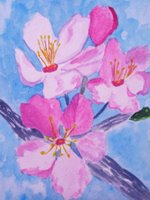
Crab Apple Blooms are abundantly found in the USA in hues of pearly white, delicate pink and rich red. Crab apple trees are grown for ornamental purposes because of their beautiful flowers and fruits. During Spring these trees bloom in delicate colours. The unopened buds may be in one colour, but may bloom in other hues. Even as the flowers fade these trees look rich and colourful. Flowers are classified as single (five petals), semi-double (six-ten petals), or double (more than 10 petals). During autumn, the falling leaves of these trees transform into beautiful colours. These trees are used as pollenizers in apple orchards where they bloom along with the apple trees.Crab Apple flower essence is used as a natural remedy to help alleviate feelings of self-hatred and uncleanliness. It is used in the treatment for facial skin rashes. Also found to be helpful during fasting periods.
(Source for note: wikepedia; treehelp.com and about.com)
CANADA THISTLE by Manisha

This flower is only about an inch in height and even less in width. It was like a blur of color on the wet ground in Morrison, Colorado. Morrison is about 8000ft in altitude. The roots of the Canada thistle can spread more than 15 feet horizontally and its roots may grow into the soil anywhere from 6 to 15 feet deep.
Unlike the Buffalo Bur which tosses its spiny seeds into the path of all that may trod that way, the Canada thistle a creeping perennial that reproduces from vegetative buds in its root system. Roots and shoots can give rise to new plants. That's not to say that it does not produce seeds. This picture was taken towards the end of September.It looked like it was done flowering and already producing seed.
It can produce between 1000 to 1500 seeds per flowering shoot and seeds are responsible for long distance dispersal. The feathery pappus helps disperse the seeds. However it is known to fall off leaving the seed attached to the plant, requiring other modes of dispersal. Seedlings grow slower and are subject to competition from other weeds especially as they are not backed by an extensive root system. Nevertheless, its seed should not be underestimated as it can remain viable in the soil for 20 years. The deeper it is buried, the longer it is viable.
Canada thistle has spread throughout the US except the south-eastern region. In Colorado, it is found in the plains and foothills, flowering from July to September. It is classified as a noxious weed.
References: Colorado State University Cooperative Extension
Guide to Colorado Wildflowers Vol 1 Plains & Foothills and Guide to Colorado Wildflowers Vol 2.
Plains & Foothills and Guide to Colorado Wildflowers Vol 2.
CHIVES by Giniann
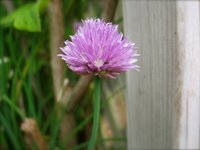
Chives are abundant in during spring and summer. They have small purple heads and have a lot of oniony flavor. Some say chives and roses grow well together and I think this is true.The chives under the roses flourish much more than the ones that are standing alone.
CICERBITA by Anita
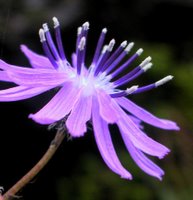
Cicerbita is a low growing alpine wildflower from the Aster family. The sun-loving herbacious plant with a mounding habit produces clusters of blue-mauve flowers high above. Flowers from July-Sept. Local people use the plant to treat headaches. It is also used in Chinese medicine.
Photographed in the Valley of Flowers and nearby areas (Nanda Devi Biosphere Reserve), Chamoli district, Garhwal (Uttaranchal).
COSMOS by Sree

Also called the Mexican Aster, these flowers are so light and delicate they sway like grass in the wind, almost reminding one of dandelions! They belong to the 'Asteraceae' family, they grow up to 3.2 metres in height. The flower color varies between species, most common ones being yellow, orange, purple and white
Round-up for C on the 18th
Hope to see some really cool flowers as well as new participants!
'C', you're on!
The guidelines remain the same; the letter changes to C.
Please send in all your entries by Oct 18, 2006 to flowerfestival[at]gmail[dot]com.
Will we see more entries this time? I hope so, if the increase in traffic to this blog is any indication, we will!! So unleash that creative talent and send in a picture, drawing, sketch, doodle, photograph of a flower whose botanical or common name begins with the letter C.
Sree will be doing the round-up for C, after the deadline of October 18, 2006.
Round-up of "B"
B
Here are the entries for the second round of the Flower Festival:
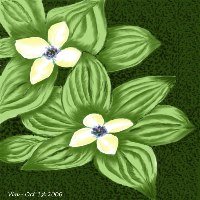 Bunchberry (Sent in by Vin of http://www.avlokana.com/ ) : BunchBerry is kind of a wild flower, the plant grows slowly but requires little care. The bunchberry flower is a small flower that has four petals and is mostly white in color. The beauty apparently comes for its placement over its green leaves creating a contrast.
Bunchberry (Sent in by Vin of http://www.avlokana.com/ ) : BunchBerry is kind of a wild flower, the plant grows slowly but requires little care. The bunchberry flower is a small flower that has four petals and is mostly white in color. The beauty apparently comes for its placement over its green leaves creating a contrast. Butterfly Bush (Sent in by Ginian of http://giniann.wordpress.com/) : The butterfly bush is usually pruned in late winter. In the spring, they start growing back and grow to large sizes by summer. Almost always, you can find butterflies and bees gathering around this bush. Doesn’t need any special care, other than pruning them in winter.
Butterfly Bush (Sent in by Ginian of http://giniann.wordpress.com/) : The butterfly bush is usually pruned in late winter. In the spring, they start growing back and grow to large sizes by summer. Almost always, you can find butterflies and bees gathering around this bush. Doesn’t need any special care, other than pruning them in winter.
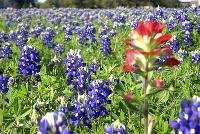 Blue Bonnets (Sent in by Hema of http://vegconcoctions.wordpress.com/) : Blue bonnets start blooming in early spring and blankets of these wild flowers can be seen throughout central and south Texas from late March to early May. It is named for its blue color and the resemblence of its petals to a woman’s sunbonnet (worn as head coverings during the 18th century). They typically grow about 1 feet tall.
Blue Bonnets (Sent in by Hema of http://vegconcoctions.wordpress.com/) : Blue bonnets start blooming in early spring and blankets of these wild flowers can be seen throughout central and south Texas from late March to early May. It is named for its blue color and the resemblence of its petals to a woman’s sunbonnet (worn as head coverings during the 18th century). They typically grow about 1 feet tall.
 Bird of Paradise (Sent in by Paavani of http://www.paavani.in/blog/) : The name Bird of Paradise comes from the spectacular flower shape, which resembles a bird’s beak and head plumage. They have banana shaped leaves and that’s why it was classified in the banana family Musaceae, but now got own family Strelitziacea. You will be amazed if you see how its blooms. Long stemmed flowers emerge from green boat-shaped bracts, which are bordered in red or purple. The numerous pointed petals of brilliant orange are contrasted with an arrow-shaped tongue of vivid blue. Some species have white and blue. The flowers have several “sets” of flowers in each bract, which are formed on the end of a stalk.
Bird of Paradise (Sent in by Paavani of http://www.paavani.in/blog/) : The name Bird of Paradise comes from the spectacular flower shape, which resembles a bird’s beak and head plumage. They have banana shaped leaves and that’s why it was classified in the banana family Musaceae, but now got own family Strelitziacea. You will be amazed if you see how its blooms. Long stemmed flowers emerge from green boat-shaped bracts, which are bordered in red or purple. The numerous pointed petals of brilliant orange are contrasted with an arrow-shaped tongue of vivid blue. Some species have white and blue. The flowers have several “sets” of flowers in each bract, which are formed on the end of a stalk.
 Buttercups (Sent in by Anita of http://madteaparty.wordpress.com/) : Buttercups are usually yellow but sometimes, also white. Most buttercups have five to six petals, and numerous spirally arranged stamens surrounding the green center. After pollination this green part which is a number of distinct tapering pistils, will develop into a small dry fruit, the achenes. True to the genus, the leaves are deeply tri-lobed.Buttercups get their name from a small cup-like feature, called the nectariferous spot, at the base of the petals that keeps nectar for the pollinating insects; their treat for helping out! Anita has a series of beautiful pictures of Buttercups in her blog. Do check out her blog.
Buttercups (Sent in by Anita of http://madteaparty.wordpress.com/) : Buttercups are usually yellow but sometimes, also white. Most buttercups have five to six petals, and numerous spirally arranged stamens surrounding the green center. After pollination this green part which is a number of distinct tapering pistils, will develop into a small dry fruit, the achenes. True to the genus, the leaves are deeply tri-lobed.Buttercups get their name from a small cup-like feature, called the nectariferous spot, at the base of the petals that keeps nectar for the pollinating insects; their treat for helping out! Anita has a series of beautiful pictures of Buttercups in her blog. Do check out her blog.
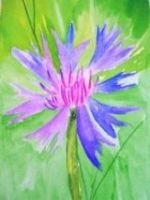 Bachelor's Button (Sent in by Priya of http://fromnaturetome.blogspot.com/) : a.k.a Cornflower grows wildly in the fields of Europe. They bloom with little care and are a favorite with gardners. These bright blue blooms appear from summer to early fall. It was declared a national emblem of unity in Germany. These plants generally grow to a height of 1-3 feet and are easy to maintain in dry flower arrangements cause they retain their colour well. They attract a lot of butterflies, bees and birds.
Bachelor's Button (Sent in by Priya of http://fromnaturetome.blogspot.com/) : a.k.a Cornflower grows wildly in the fields of Europe. They bloom with little care and are a favorite with gardners. These bright blue blooms appear from summer to early fall. It was declared a national emblem of unity in Germany. These plants generally grow to a height of 1-3 feet and are easy to maintain in dry flower arrangements cause they retain their colour well. They attract a lot of butterflies, bees and birds.
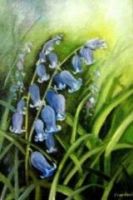 Bluebells (Sent in by Sree of http://sreescanvas.blogspot.com/) : Also called Wild Hyacinth ( quite a striking resemblance to the water hyacinth both in color and form). Sree quotes from a description of these blue beauties - The bluebell, popularly thought of as Britain's national flower, is a bulbous spring flowering plant. When growing en masse in woodlands it creates a dazzling display of brilliant blue, which is not only a great wild flower phenomenon, but also a British speciality. The fragrant bell-shaped flowers stand upright when they are in bud, but hang downwards, nodding in the breeze when fully open; they may be violet-blue, white or even pink on rare occasions, and have cream-coloured anthers. They are arranged in clusters of 4-16 on flower spikes (known as racemes), which have drooping tips.
Bluebells (Sent in by Sree of http://sreescanvas.blogspot.com/) : Also called Wild Hyacinth ( quite a striking resemblance to the water hyacinth both in color and form). Sree quotes from a description of these blue beauties - The bluebell, popularly thought of as Britain's national flower, is a bulbous spring flowering plant. When growing en masse in woodlands it creates a dazzling display of brilliant blue, which is not only a great wild flower phenomenon, but also a British speciality. The fragrant bell-shaped flowers stand upright when they are in bud, but hang downwards, nodding in the breeze when fully open; they may be violet-blue, white or even pink on rare occasions, and have cream-coloured anthers. They are arranged in clusters of 4-16 on flower spikes (known as racemes), which have drooping tips.

Buffalo Bur (Sent in by Manisha of http://inner-lens.blogspot.com/) :
This is the Buffalo Bur from the Solanum rostratum genus. It's barely 1 inch across in width and is the bane of most off-road cyclists. Buffalo Bur is from the Nightshade family and apparently, the foliage and the unripe fruit of most nightshades contain dangerous levels of a steroid alkaloid, solanine. The ripe berries are the least toxic part of these plants. Buffalo bur has long, yellow spines on stems, leaves, and flower heads as can be seen in the photo above. They grow up to 2 feet high and are drought resistant. The flowers bloom in summer. By fall, the spiny fruit or the berries, if you will, develop and are up to 1/2 inch in diameter.
If you missed getting your entry in for this round-up, we still have 3 more days before 'C' becomes the letter in focus. So send in your entry to flowerfestival[at]gmail[dot]com as soon as possible and we'll slip it into this round-up.
Round-up for B coming up!
Looking forward to seeing your art in your flowers!

